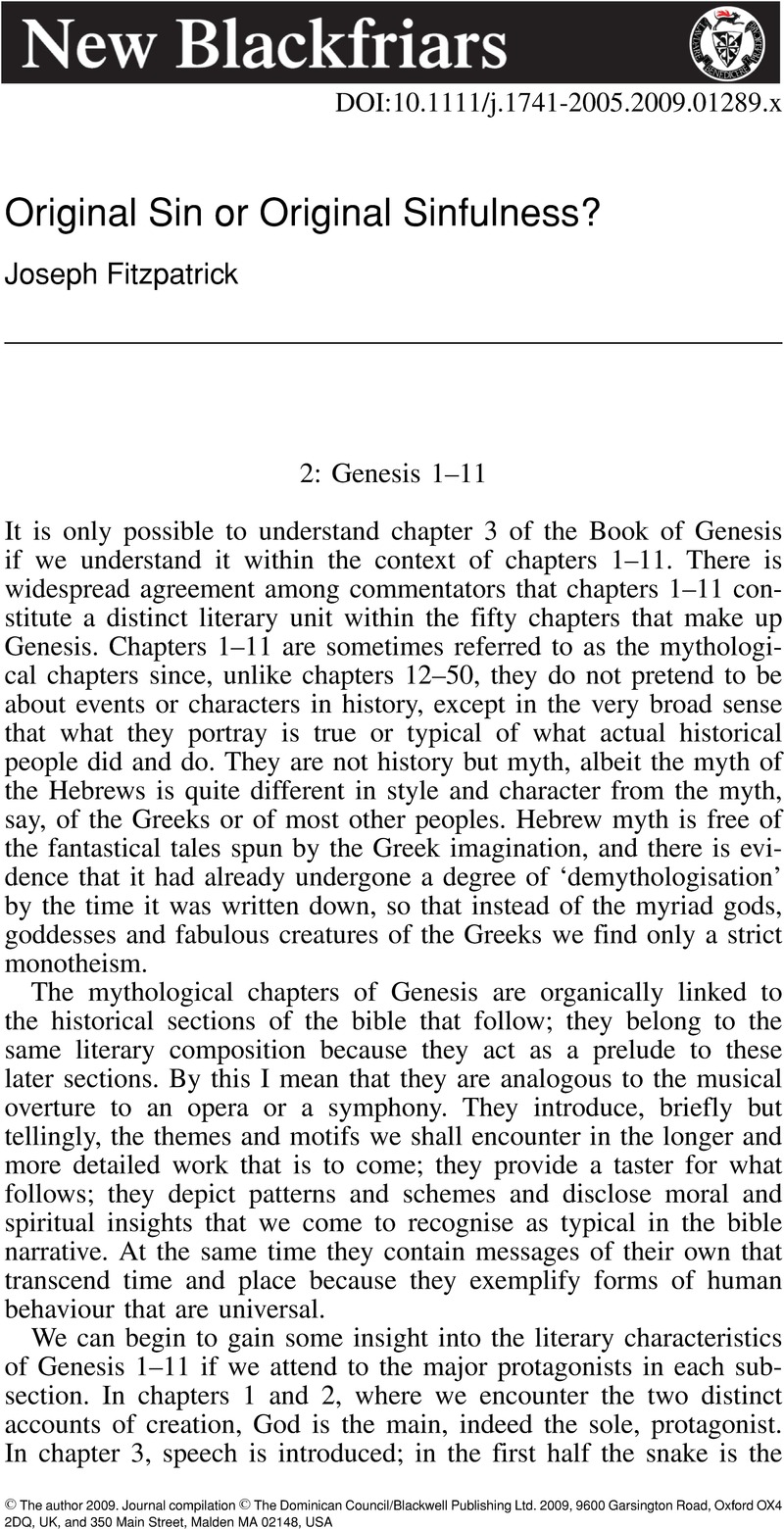No CrossRef data available.
Article contents
Original Sin or Original Sinfulness?
Published online by Cambridge University Press: 01 January 2024
Abstract

- Type
- Original Articles
- Information
- Copyright
- © The author 2009. Journal compilation © The Dominican Council/Blackwell Publishing Ltd. 2009, 9600 Garsington Road, Oxford OX4 2DQ, UK, and 350 Main Street, Malden MA 02148, USA
References
1 I shall attempt to use inclusive language in these articles but references to “humanity”, “human beings” and “humankind” as well as “his/her” can become cumbersome, so I have sometimes fallen back on the simple monosyllable “man”, but to indicate when it is used in its generic sense I have capitalised the M.
2 Barr, James, The Garden of Eden and the Hope of Immortality (SCM 1992), 62Google Scholar.
3 Ibid., 63.
4 Max Muller, Professor of Comparative Philology at Oxford and contemporary of Darwin's who held anti-Darwinian views on the evolution of human cultures, claimed that language formed an impassable barrier between Man and beasts, that language was the “Rubicon” that mere animals could never cross. This view has been contested by modern zoologists who point to elaborate systems of communication among different groups of animals which are in part vocal; by contrast, in my interpretation, in Genesis the Rubicon is presented as the wearing of clothes.
5 Augustine, Confessions, Book Thirteen, XV.
6 Commenting on the thinking of one primitive tribe, the anthropologist Mary Douglas says they believe “It is the nature of humans to reproduce with pain and danger … By contrast, it is thought that animals … reproduce without pain or danger.” See Purity and Danger (Routledge 1966), 169Google Scholar.
7 James Barr, op. cit., 71.
8 Ibid., 60.
9 The author who has provided the most penetrating and illuminating account of human consciousness, in my opinion, is Bernard Lonergan. See, for example, the references to consciousness in his Method in Theology (Darton, Longman and Todd 1972). See also Fitzpatrick, Joseph, Philosophical Encounters: Lonergan and the Analytical Tradition (University of Toronto Press 2005), 211 and 215CrossRefGoogle Scholar.
10 Douglas, Mary, Purity and Danger: An Analysis of the Concepts of Pollution and Taboo (Routledge 1966)Google Scholar.
11 Iersel, B. Van, The Bible on the Living God (Sheed and Ward 1965)Google Scholar; original Dutch publication 1962. Much of this section is indebted to this book, notably to chapter 6.
12 Ibid., 50.
13 Ibid., 51: “Uncleanness here is the exact opposite of holiness; and this makes it easier for us to understand why ancient Israel put so much store by her purity laws. We often do not know the exact reason for holding certain objects and actions unclean; what is certain is that contact with them placed man in a sphere which was the very opposite of Yahweh's.”
14 Mary Douglas, op. cit., 50–55.
15 Ibid., 56.
16 Ibid., 51–2.
17 Ibid., 54–5.
18 Ibid., 46–7.
19 Ibid., 46.
20 Ibid., 58.
21 Ibid., 96.
22 Douglas, Mary, Natural Symbols: explorations in cosmology (Cresset Press 1970), 38Google Scholar.
23 Ibid., 114.
24 Ibid.
25 Ibid., 97.
26 Ibid.
27 Mary Douglas was a student and associate of E.E. Evans-Pritchard who in Theories of Primitive Religion (Oxford University Press 1965) is critical of various modern psychological and sociological theories put forward by anthropologists that attempt to explain how primitive people came by their irrational beliefs by attributing to them the steps by which they themselves might have come to entertain such beliefs. By contrast, Evans-Pritchard claims that primitive people reason intelligently from premises we consider absurd; but we can follow their reasoning and it is wrong to treat them as unintelligent. He approves of Levy-Bruhl's position of seeing religious beliefs as “meaningful when seen as parts of patterns of ideas and behaviour, each part having an intelligible relationship to the others” (p 86).
28 Ibid., 40.
29 Ibid., 39.
30 Ibid., 162; Eliade, Mircea, Patterns in Comparative Religion, London 1958Google Scholar.
31 O’Collins, Gerald SJ, “The Virginal Conception and Its Meanings”, New Blackfriars, Vol 89 No 1022, July 2008, 432Google Scholar.
32 I should make it clear here that I use the words “history” and “historical” in the context of the bible in a rather broad sense, meaning that which is presented in the bible as history, as a record of events that took place. What is presented in the bible as history, however, may not always meet the standards modern scholarship requires for something to qualify as “history”. By these standards, for example, the biblical figures of Abraham and Moses conform more to legend than to history.
33 Lonergan, Bernard SJ, A Second Collection, (Darton, Longman and Todd 1974), 173Google Scholar.




